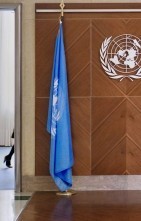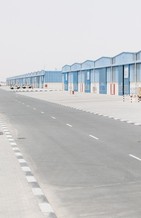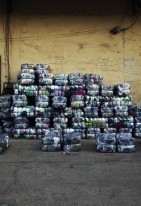At first glance, all seems well at the open-air market in the Philippine city of Tacloban. You smell the bananas and big skewers of meat smoking on the grill. On the ground, you see piles and piles of mangos, secondhand clothes, and fans woven from palm leaves.
But take a closer look and you can tell this is a disaster area. You can tell from the logos.
Look at the fruit seller there, taking shelter from the hot sun under a pink UNICEF parasol, her wares laid out on a USAID tarp. And there’s her child in his school uniform with a dark blue Plan International rucksack at his feet.
The traffic honking its way through the market street speaks volumes. The characteristic tricycles and pedicabs – motorbikes and bicycles with sidecars that serve as taxis – are cut off by big 4-wheel-drive vehicles bearing stickers of aid organizations. From the sidewalk, I make a list in my notebook of the army of relief organizations passing by:
IFRC
FAO
ILO
UNDP
MSF
OCHA
Red Cross
IOM
CRS
WFP
Save The Children
Oxfam
WHO
CSFI
Unicef
ACF
UNFPA
USAID
Plan International
UNHCR
Precisely one year ago, one of the strongest typhoons ever hit the Eastern Visayas, a region of the Philippines with Tacloban as its capital. Typhoon Haiyan – or Yolanda as it is called in the Philippines – destroyed the homes of 4 million Filipinos and killed some 6000 people.
In its wake, aid organizations moved into the affected area. The U.N. alone requested a total of $776 million in humanitarian funding for this disaster. Now, nearly a year later, photographer Pieter van den Boogert and I have come to the Philippines to report on the recovery efforts.
How can you, as a disaster-stricken country, ensure that aid gets to the right place? And how can you make sure you stay in charge, when the entire international community is at your doorstep?
An arranged marriage
Aid organizations cannot simply show up. They must be asked to come by a country’s government. And governments do not extend such invitations lightly. Especially in Asia, it can be considered a weakness if a country cannot deal with a disaster on its own. That can make cooperation with international parties seem more like an arranged marriage than anything else.
Following a disaster, the ‘marriage license’ is signed under considerable time pressure; in most cases, the bride and groom barely know one another. "We had to provide immediate assistance, but had never before worked with the local authorities," says Kasper Engborg from the United Nations Office for the Coordination of Humanitarian Affairs (OCHA) in Tacloban.
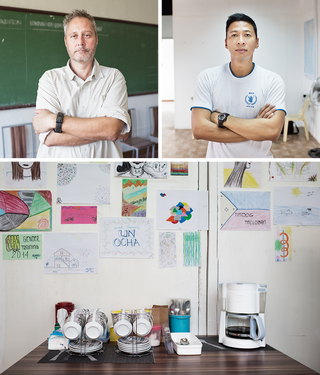
Left: Kasper Engborg, Head of the United Nations Office for the Coordination of Humanitarian Affairs in Tacloban. Right: Geovani Lapina of the World Food Programme, which is now pulling out of the region. Pieter van den Boogert for The Correspondent
And as in every marriage, certain issues lead to squabbling. But the married couple would rather not air its dirty laundry. For the outside world, both parties play their part of the happy couple, the grateful bride and groom with the favorable dispositions. Aid organizations emphasize their supportive role again and again: They are here to support the government and help the people in the face of this disaster.
Yet there is certainly tension between governments and this army of support. Suppose the Philippine government and the aid organizations were to go into marriage counseling. What issues does each partner face? And how does the tension in the relationship affect the children – or the population?
Source of tension #1: Who makes the plan?
The press conference in early December 2013, in which the international community presented its emergency relief plan for the Philippines, started a little uneasily. The Humanitarian Coordinator of the U.N. explained in her speech how the international aid organizations were there to support the Philippine government, with the emphasis on "support." The humanitarian operation took place entirely "under the leadership of the local authorities."
The Philippine government may be officially in charge, but the U.N. is not going to wait until the government takes charge.
Then came the first question: Great, but what is the Philippine government’s plan, then? The Humanitarian Coordinator was silent for a moment, then conceded she had not yet seen the plan.
Two days later, the Philippine government announced its plan. "The U.N. was not involved in its creation," a source high in the U.N. tells us, who due to his position can only speak on condition of anonymity. "It was pure luck our plans dovetailed."
It reveals the first point of contention in the arranged marriage: the Philippine government may be officially in charge, but the U.N. is not going to wait until the government takes charge. Following a disaster, speed is of the essence. The U.N. official asserts dryly, "We don’t make plans together, yet for the outside world our help gets labeled as government help."
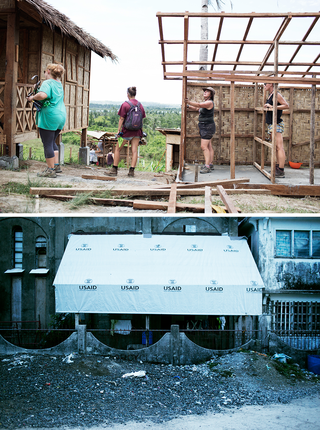
Western volunteers help build new, temporary housing close to Tacloban. Pieter van den Boogert for The Correspondent
Source of tension #2: Who gets which piece of the relief pie?
Something you notice immediately in the Philippines are the gates. Every neighborhood has one, often complete with decorative wrought iron lettering. The Filipinos divide their communities into numbered districts – barangay. Each barangay has a democratically elected council and neighborhood leader, frequently a woman.
At this level, the marriage runs smoothly. Because the barangay leadership knows all the residents, it is a fantastic structure for gaining some insight into the community’s needs. Which families are most in need? The barangay leader has a list. This saves time and money and enables relief efforts to get moving quickly and effectively.
But there is one crucial problem: Politics in the Philippines is dominated by centuries-old family clans. At the local level, it is often the candidate with the biggest family who wins elections. And yes, there are also rumors of barangay leaders bumping members of their own clans up the lists provided to aid organizations.
Furthermore, the family clan issues go beyond the local level. The two largest families often pitted against each other in the Philippines are the Marcos family (descendants of the former dictator Ferdinand Marcos) and the Aquino family. The President of the Philippines, Benigno Aquino III, belongs to the latter clan, while Tacloban’s Mayor Alfred Romualdez belongs to the Marcos clan.
Aid organizations coming into the Philippines have inherited this delicate political situation. In Tacloban, everyone complains that the government has left them in the lurch. The president refused, for instance, to swiftly transfer funds to the mayor. Other cities, with Aquinos in power, received additional funds much more quickly.
Source of tension #3: Who are all those foreigners?
Barangay 88 is one of the areas hardest hit in Tacloban. Situated on a cape protruding into the sea, it was battered from both sides by the
storm surge.
When asked how many people live there, district leader Emelita Montalban gives a wan smile. "Do you mean before or after Yolanda?" Before the typhoon, the district’s population was 11,500. Since the storm, that number has dropped to between 8000 and 9000. Many people died, still more fled, leaving the destruction behind.
Montalban shows us around her neighborhood. There are concrete walls spanned by tarps instead of roofs. Some 300 families live in tents, spread out over eight small camps. The tents are mildewed and worn, and they flood on a regular basis. "So many NGOs have come to help," says Montalban, as she ducks under a clothesline between two tents. "I try to coordinate their efforts, but many don’t even come to me. They just start handing out boats or money. That’s why I don’t have a clear overview of who’s getting what."
There’s almost no debris left in Tacloban, but the farther you drive out of town, the greater the destruction you see.
It is a story we hear time and again: no one knows just how big a dowry the aid organizations brought with them. Kasper Engborg from OCHA explains that a great deal of the response has been carried out by non-traditional humanitarian actors, mostly faith-based associations. "And they have made it known they do not wish to work with us," he sighs. The vast majority of the population is Catholic, and the country has a vast network among foreign churches, particularly in the U.S. "We agreed to adhere to certain wages for local personnel, so we wouldn’t draw anyone away from the local private sector," Engborg explains. "But some of these organizations offered salaries ten times as high."
No one knows precisely how many organizations are involved, but Engborg guesses it is in the hundreds. The OCHA earmarked some $400 million for the Philippines. The organization estimates that the churches managed to raise even more. "That’s millions of dollars in aid that doesn’t show up anywhere in the data," says Engborg. "Even the government has no idea how much money has come in and where it has gone. It moves from church to church."
If the government cannot keep track of it all, how are local personnel expected to survive in the midst of all these relief troops? Take Dr. Ofelia Absin, for instance, Director of the Leyte Provincial Hospital. In her office, off a hall with mint green walls and lined with beds filled with mothers and newborns, Dr. Absin tries to name all those who have tried to help the hospital. "The Korean army renovated the Emergency Room, Action Against Hunger does food, Doctors without Borders does the maternity ward and runs one of the ORs, Mercy Malaysia did the roof, the Health Department supports us…." She stops to think for a moment. "And Plan International did a couple of rooms in the children’s wing, but then because of that, AmeriCares would no longer do the rest of the wing. Oh yeah, and the Mormons keep promising to replace the anesthesia equipment."
And there is another downside. Many organizations focus on locations that are easy to reach, such as Emelita Montalban’s district close to the airport. Almost no debris is left in Tacloban, but the farther you drive out of town, the greater the destruction you see: Entire villages consisting largely of plastic tarp; power line towers crumpled over as if the steel had turned to rubber. Tens of thousands of decapitated palm trees, like so many headless matches lining the coast.
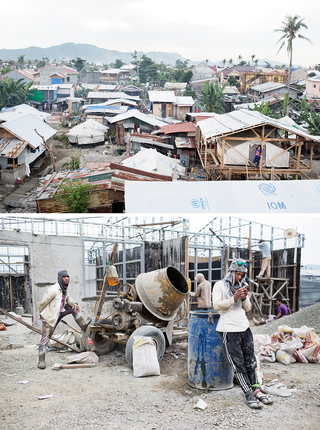
Above: Barangay 88 in Tacloban. Below: New construction in the hills north of Tacloban, where it is safer. Pieter van den Boogert for The Correspondent
Source of tension #4: Where can we build?
In the middle of Barangay 88, on the San Pedro Bay, some 1200 people live in tents. The ground is muddy. A long line of blue, green, and white jerry cans stand ready by the water pump. The women wait their turn in the shade, next to a painted concrete post, yellow with black letters that read "no-build zone."
You can see these posts all over Tacloban – at the side of a busy road, on a basketball court, in the middle of the slums. No one seems to pay them any mind, but the yellow posts are of great importance for humanitarian assistance. They mark off a distance of 40 meters from the coast (approximately 44 yards, or 130 feet), the zone determined to be fundamentally unsafe for housing.
The fact that most people in the area make their living fishing, and live close to the coast, makes this rule somewhat complicated. It means that 60% of the population of the islands has to move. But Mayor Romualdez thinks it is worth it. Sitting at his L-shaped desk, in a black leather desk chair that is far too big, he says, "People have to realize that you cannot live in those danger zones. You will die there. We simply cannot manage to evacuate everyone."
Romualdez does not grant aid organizations permits to build new houses within this coastal zone, not even to replace the homes destroyed by the typhoon. And that turns out to be a troublesome prenuptial agreement. Where are the aid organizations supposed to build then? Land is hard to come by in the Philippines. It is often unclear who the landowner is, and aid organizations operate under tremendous time pressure, as their allotted budgets must often be disbursed within one year.
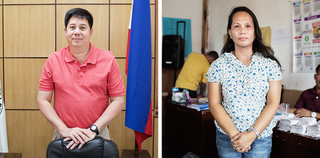
Left: Alfred Romualdez, the Mayor of Tacloban. Right: Emelita Montalban, Barangay Leader of neighborhood 88. Pieter van den Boogert for The Correspondent
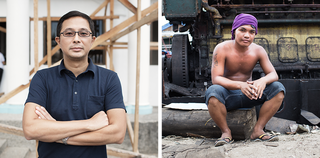
Left: Jerry Yaokasin, Vice Mayor of Tacloban. Right: Amel Amosco, who lives in the Anibong district of Tacloban. The district now calls itself "Yolanda Village." Amosco works dismantling a freighter the storm washed ashore. Pieter van den Boogert
For this reason, the organizations now all opt for temporary housing. These transitional shelters, or "T-shelters," are built on land made available by the owner on a temporary basis, for instance for five years. They are located in the hills, some distance from town. Whether permanent homes will eventually be built for these families remains to be seen. Many aid organizations see this as a task for the government.
And permanent homes are going up in some places. Less than 50 meters (about 55 yards) from the foot of the Santo Niño dump, for example, dozens of men are hard at work with cement mixers and metal framing. A new housing development is in the works.
But what if people do not want to move to new locations? Nearly all of Barangay 70, in the Anibong district, lies within the no-build zone. Yet residents have constructed new slums, some on stilts. At the entrance to the neighborhood, a sign announces the area’s new nickname, "Yolanda Village." The homes are obscured from view by an enormous freighter, stranded during the typhoon. A toddler wearing only a shoelace around his waist sits on a pile of heavy ropes stacked against the red hull of the ship. All around him, people are drilling, hammering, sawing – dismantling the ship for scrap will take at least another year.
Bienvenido Abrea, one of the barangay leaders in Yolanda Village, tells us that he and the other 1200 people in the neighborhood do not want to move away from the coast. "We have lived here all our lives. We are used to the dangers of the sea, and disasters come and go. How can we make a living if we live somewhere else?" His flip-flops are made from old tires. "Build us a dike instead of sending us away."
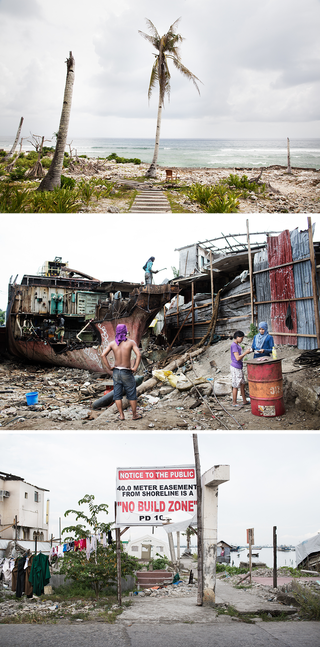
Above: What is left of the surf resort in Sulangan. Middle: A freighter stranded during the storm is scrapped in the Anibong district. Below: A sign alerts the public to the no-build zone. Pieter van den Boogert for The Correspondent
Source of tension #5: When is it over?
Last July, what should have been regular cluster meeting ended extremely unpleasantly for aid organizations. Government officials let aid workers know in passing that as far as the government was concerned, the humanitarian phase was over. "It was a complete shock," says a source inside the U.N. "The government gave us no warning. They just said, ‘You don’t have to come to us anymore to discuss humanitarian needs; we no longer recognize them.’"
Of course officially, we go out and praise the government for its strong leadership and great support.
The earlier the official period of emergency relief ends, the better the government looks. It shows the voters and the outside world how quickly the government got the disaster under control. "It’s a political decision. Whether they are right or wrong, we have to determine how we continue or how we pull out," says our source. "Officially, we go out and praise the government for its strong leadership and great support. Things may work differently in Manila, but here, the government doesn’t tell us anything."
The ultimate recipients of relief face great uncertainty. "People don’t know where they stand – whether they should stay in their temporary housing or not," explains Benilda Albao, of the U.N. Refugee Agency the UNHCR, which is holding an information session for Yolanda victims. "They just see that the private landowner here has posted a flyer saying they must vacate within six months. That creates panic. People are upset their government isn’t providing them with any official information."
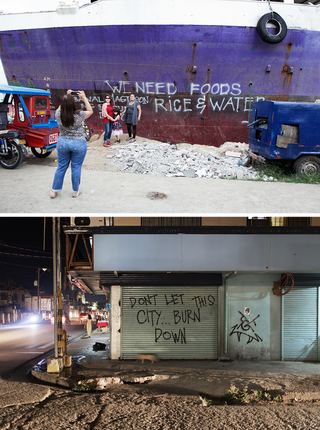
Above: "Yolanda Village" in Tacloban, where freighters washed ashore during the typhoon. Below: Downtown Tacloban. Pieter van den Boogert for The Correspondent
The marriage counselor
And what would the marriage counselor recommend after hearing from both local authorities and aid organizations? A good therapist would likely point out that there is clearly a relationship here.
The same cannot be said of all disaster areas. The Philippines have not been completely snowed under by all the relief assistance. In the past year, they drew up rules for aid organizations to abide by, they made decisions. And let’s be honest: The marriage is still very young.
But perhaps the marriage counselor would also say: stop keeping up appearances for the outside world; just work together.
While waiting for our interview with the Mayor in a city hall scarred by Yolanda – ceiling tiles are hanging, the stairwell windows have no panes – a young British woman walks in. She represents an aid organization and needs the mayor’s "approval" to build some houses. "If he could just sign here."
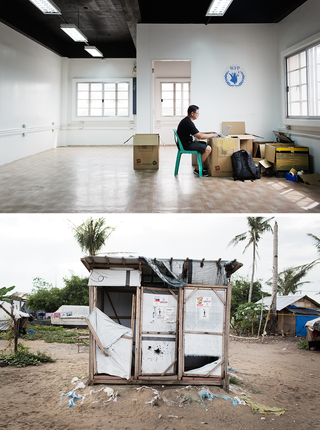
Above: The World Food Program offices in Tacloban are all packed; the humanitarian phase is over. Below: The public bathroom facilities in the tent camp in neighborhood 88. Pieter van den Boogert for The Correspondent
Would you rather read this article in Dutch?
This series was made possible in part by grants from the Dutch Foundation for Special Journalism Projects and from the National Postcode Lottery Fund for Journalists, awarded by Free Press Unlimited.




